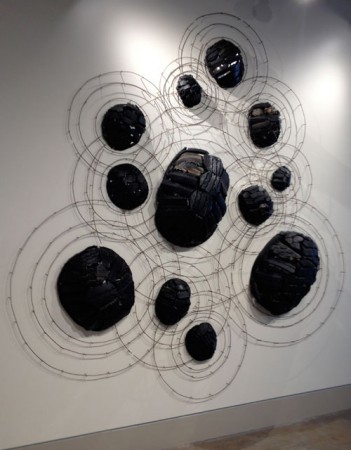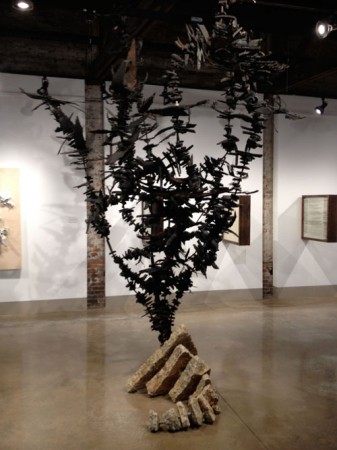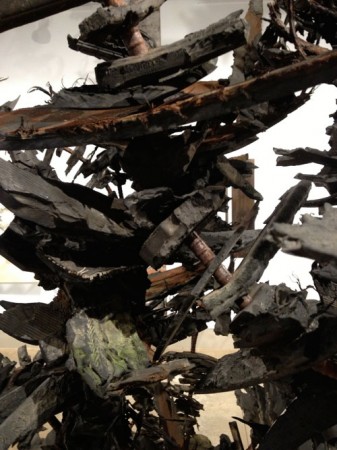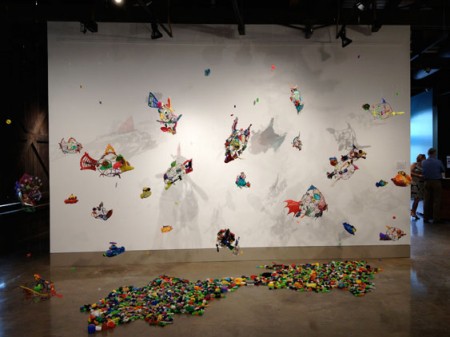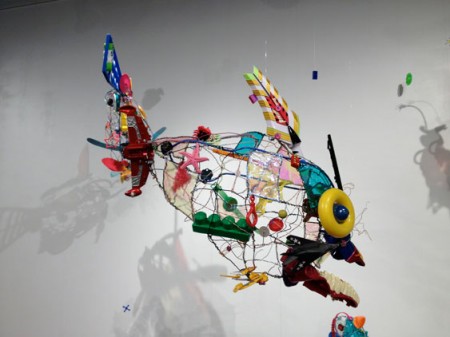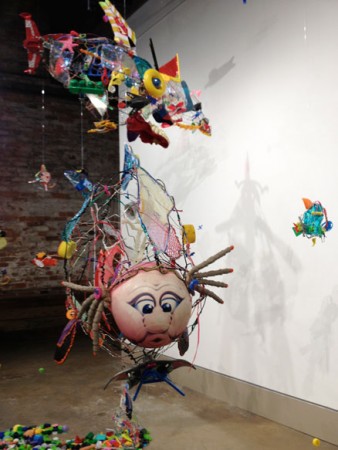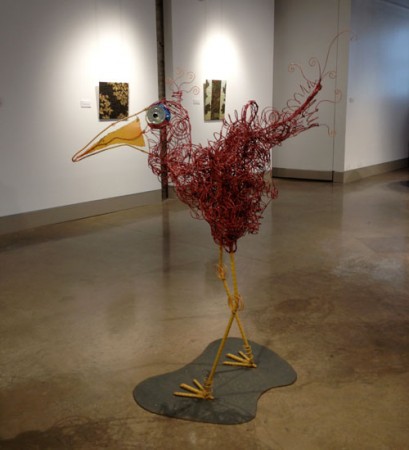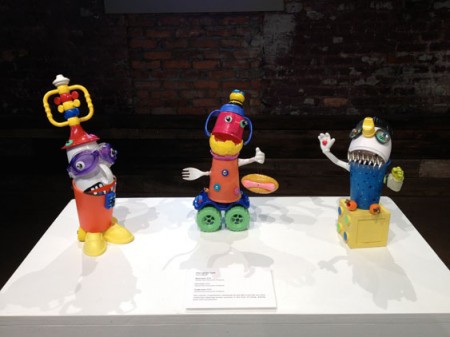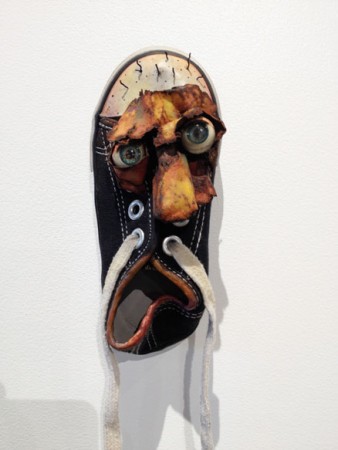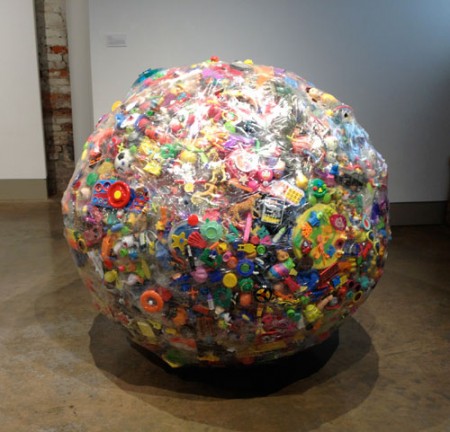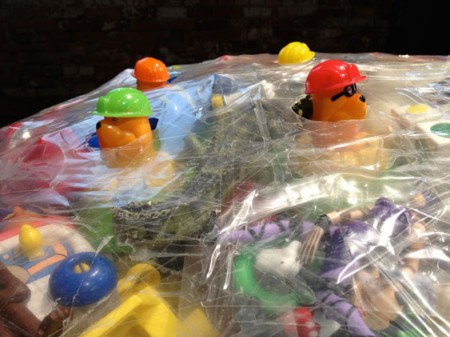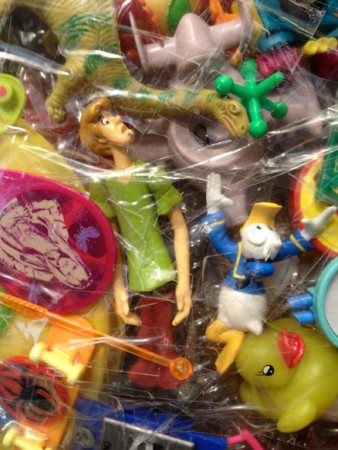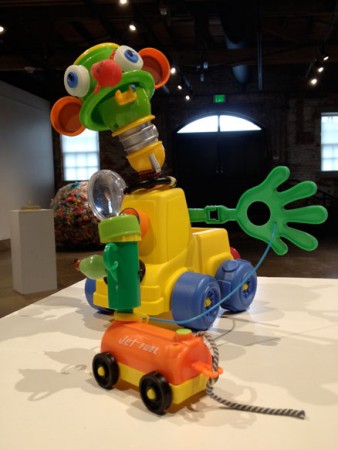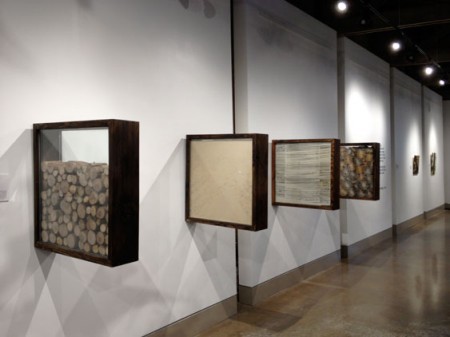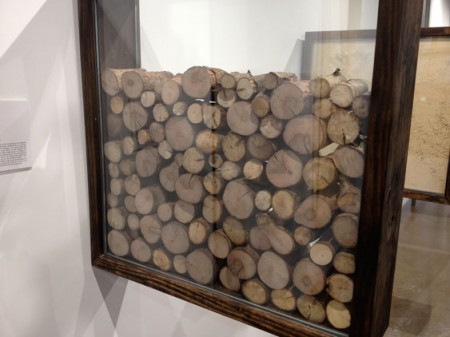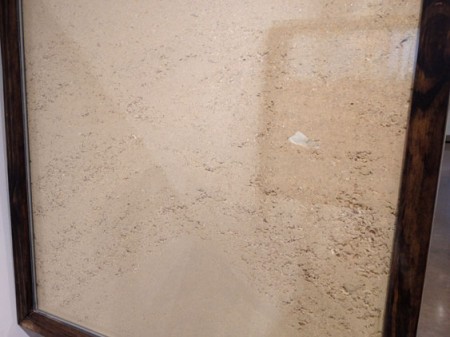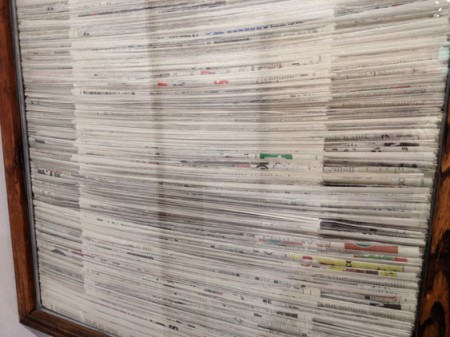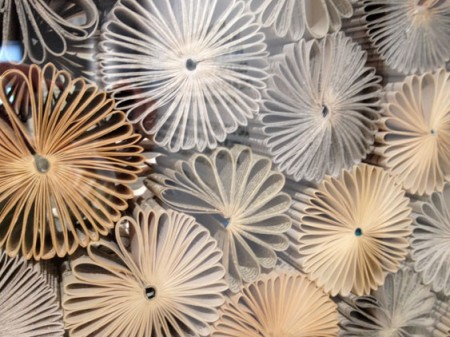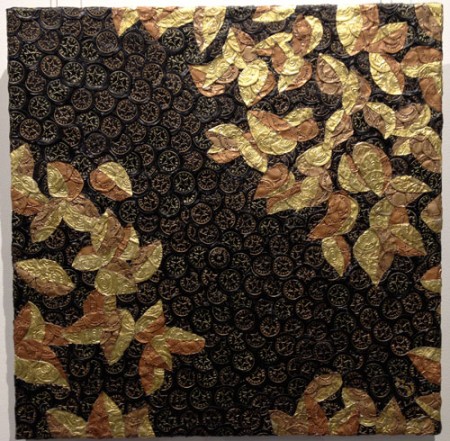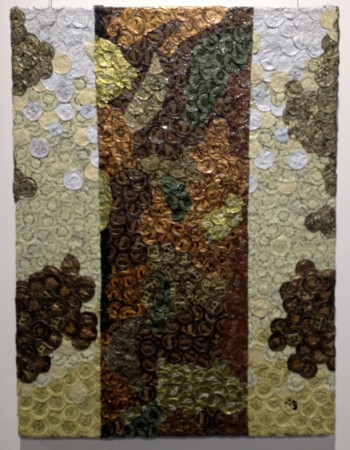On a day when it was thundering and lightening around the lake here in Bonneau, SC, I decided to head over to the Pee Dee area of South Carolina, to see a few exhibits on view in Lake City, SC, and Florence, SC, just an hour’s drive north on Hwy. 52 (Lake City is one hour away). If the computer had to be unplugged, why not go somewhere else where the weather is not so angry.
The Jones-Carter Gallery in Lake City, is presenting “Upcycled: The Art of Reclaimed Objects”, an exhibition on view through Aug. 23, 2014. The exhibit features works by Natalie Abrams (Charlotte, NC), Patz and Mike Fowle (Hartsville, SC), Randy Gachet (Birmingham, AL), Jordan Morris (West Columbia, SC), Greg Mueller (Spartanburg, SC), and Amelia Sherritt (Seattle, WA), the show explores the ways in which post consumer products can be upcycled into intriguing works of fine art.
I’m doing this blog post in parts to keep it from being so long. Part I is about the exhibit at the Jones-Carter Gallery and a few other notable items related to Lake City.
When you walk in the door you are confronted by a large work by Randy Gachet entitled, “Repercussions”, 2008, made of reclaimed rubber tire, steel wire, and acrylic mirror. Gachet explains that in the 1990′s he started noticing that the rubber tire remnants seen along the roads were beginning to take forms in his mind – crow wings, tortise shells, and alligator hides. I’ve seen a few of those alligator hides along the road in my travels. “Repercussions” reminds me of a group of turtles in a pond with the ripples of water emitting from their shells. I’m not sure what function the mirrors served as I couldn’t see any effect from them.
In “Carbon Plume”, 2011, a work of reclaimed rubber tire, concrete, and steel, I first thought the work depicted some kind of tree, but once I read the ID card provided I easily could see the jet black plumes rising from burning oil fields in Iraq, first seen on CNN. Gachet offers the following statement about this piece, “The rubber tire fragments in the piece were all collected along interstate highways in the Birmingham, AL, area where I live. The perpetual whir and rush of semi-trucks and automobiles implicate the voracious engines of production and consumption that hurtle them as I scavenge the highways for the detritus left behind. The resulting form is both graceful and sinister.” After reading that I kind of wished it was some kind of tree, but then I couldn’t think of any happy story lines involving trees and rubber tires.
After reading that statement it was hard to think of this exhibition as representing the ever amazing imagination of artists to make works out of junk and stuff we throw away or consume in our daily lives in America. After all we are the great consumers of the world. It’s a good thing the next works I zeroed in on were by Patz and Mike Fowle. Although their works are more whimsical – they are no less a statements on the great mountains of discarded objects we create in America.
Although this is a group show, it is clear when you get there that Mike and Patz Fowle seized the opportunity to provide many examples of how they use repurposed consumer goods – mostly, in this exhibit, discarded children’s toys. They provide 11 of the 20 works in this exhibition.
The largest piece in the show is “Post-Consumer Aquarium”, 2014, made of repurposed children’s toys, plastic and metal wire. Many of the fish-like creatures are made from plastic toys and toy parts – part of the millions of pounds of plastic produced each year in America which will last longer in boxes stacked in closets and attics or in our landfills for decades longer than they were enjoyed by a child. But now a few of those toys make up parts of artworks.
I have to say that the toys we bought our son are getting a lot of reuse by his children. We kept them all, but they won’t last another generation. His boys are rough on toys.
In another work by the Fowles, “Recycled Red Bird”, 1994, made of found bed springs, steel, sheet metal, and a glass insulator, shows that the couple also makes repurposed works from more industrial and consumer waste. They found the bed springs while exploring the Sand Hills area of South Carolina in a pile of construction debris – not in a landfill, but thrown or dumped out in the open.
These three characters produced out of the Fowle’s imagination represent colorful members of a contemporary community of cast-offs including: “Blow Hard”, 2010 (L); “Fast Food”, 2010 (C); and “Tough Love”, 2010, all made of found post-consumer products.
“Fu-Man Shoe, Jr.”, 2012, made of a found shoe, rusted metal, and doll parts, was created by Patz Fowle. She offered this statement about the piece, “When I held this little canvas shoe in my hand it made me think of the journey it had taken prior to me finding it. So, I felt compelled to give it a face that had experienced many journeys with facial features of rusted metal and the eyeballs of a forgotten doll who had seen it all.”
I first saw one of Patz and Mike Fowle’s plastic planets at an exhibit at Francis Marion University in Florence, SC. It was an amazing piece of plastic toys, toy characters, and toy parts inside a vary large ball in plastic wrap. As you examine this “planet” up close you can recognize toys from your time frame and toys from every generation there after. “Plastic Planet Redux”, 2014, by the Fowles, also includes repurposed plastic and electronic children’s toys, tape, and wheels. I took a couple of detailed images of toy characters that have been popular in our household – throughout several generations.
One more of the cast-off characters offered by the Fowles is “The Walk”, 2010, made of found post-consumer products. It represents a scene many of us are used to – walking a pet. The character walking the pet has that look of – “Come-on, we don’t have all day”.
Jordan Morris of West Columbia, SC, offered one work entitled. “The State of Things Series”, 2014, including four works: “Origins”, 2014, made of wood and glass; “Destruction”, 2014, made of sawdust, wood and glass; “Information”, 2014, made of newspaper, wood and glass; and “Creation”, 2014, made of paperback books, wood and glass. Most of the wood and glass represented the shadowbox cases holding the materials contained inside.
Morris offered this sentence in his statement on this work: “Each shadowbox contains what was once a living thing in four different forms, inviting one to consider the drastic changes that our world has been through since the advent of computers”. I didn’t get that and what was said in the rest of the statement confused me even further.
What I saw looking at these four boxes was a box of cut wooden logs, a box of sawdust, a box of shredded paper, and a box of designed objects made out of paper. Each representing the progression from trees to paper and then an interesting looking design made of paper. As someone who has taken a printed publication to an online publication, I see a lot of trees being saved by computers and the Internet. But that’s my point of view. Morris also says he pines for a return to simpler times when we were not bombarded by “waves of information” in the age of electronic media. I felt the same way when I walked into a library -way before computers came along. There has always been more information than most of us could digest – there’s nothing new there.
I thought it was interesting that Morris was the only artist in this exhibit who did not provide information about himself for the press release sent out to promote this exhibition. He could have sent a letter by snail mail, but he didn’t. Perhaps it is his own problems with today’s digital media that he describes in his statement, but I didn’t see how the works he presented would lead anyone looking at the work and reading his statement to come to the conclusion he provided.
Of course there have been times when an artist has provided a statement – several pages long describing a work of art, yet I never saw what they described when looking at the work. And, I wasn’t alone in my feelings. All I can do is apologize for not getting his point. I’m sure it’s me and my lack of higher arts education.
Amelia Sherritt, of Seattle, WA, offers works made of the foil covering the corks of wine bottles. The work “Autumn Gold”, 2013, contains hundreds, if not thousands of wine foils. Sherritt states, “By re-purposing these foils, I am able to make what would normally be thrown away into something long lasting and beautiful”. And, I bet it’s a lot of fun emptying those bottles of wine, although I’m sure she has an army of wine drinkers saving those foils for her.
Sherritt also offers, “Moss Study”, 2012. It got me wondering how many different colors are offered on all the different makes of wine out there and whether she would have to reach out to other countries for certain colors – adding travel into the process of making art. I think this artist has found the perfect materials to make her art.
Well that’s enough – you need to go see this exhibit yourself and see if these works bum you out over America’s wasteful habits or amazes you in the endless imagination of artists – or both.
The next exhibition at the Jones-Carter Gallery will be “Francisco de Goya: Los Caprichos”, on view from Sept. 20, 2014, through Jan. 3, 2015. How many small towns can host a major exhibit of works by Goya? This gallery is a place worth visiting.
It should be noted that several of these artists had participated in the two ArtFields competitions that took place in Lake City. The folks at the Jones-Carter Gallery not only keep an eye out for potential exhibitors, but they also curate some parts of the display – so they get a good look at what’s out there. Some names from those competitions are recycled when organizing exhibitions. That’s another intangible result of getting into ArtFields, much like our selection of cover art for our June 2014 issue of “Carolina Arts”, which turned out to be one of our most popular covers – if not the most popular. I first saw that artist’s work at ArtFields. So, just making the cut at ArtFields can lead to many unknown opportunities. Exposure is “King” in the visual arts. And, it’s something to think about when artists are thinking about re-entering this competition or thinking about entering it for the first time. There is more at stake than winning one of the top prizes.
I also want to warn artists who might think that Darla Moore just might buy their over priced artwork – she’s loaded right. She didn’t get that money by overpaying for things. More work was sold the first year before artists learned she bought work that first year and jacked up their prices the second year. One artist just out of college put $100,000 on their work. I hope they were embarrassed. Moore is not the only person looking to buy works at ArtFields – so don’t price yourself out of a sale. You might also scare off a gallery owner who was thinking of representing your work in their gallery, but your price was out of reason.
It also should be noted that on this trip I learned that ArtFields will be under new management in 2015. The Community Museum Society which operates the Jones-Carter Gallery will now manage ArtFields. ArtFields will be in the good hands of Ray McBride and his team of capable folks in 2015 and I think you’ll notice many changes in how the event is handled and promoted. We’ll have more about that later.
You can read a press release about this exhibit on Page 29 and 30 of our July 2014 issue of “Carolina Arts” found at (www.carolinaarts.com).
The Jones-Carter Gallery is located at 105 Henry Street in Lake City, SC, next to The Bean Market. Admission is free at the Jones-Carter Gallery and large groups are encouraged to call ahead. The gallery is open Tue.-Fri., 10am-6pm and Sat., 11am-5pm. For further information contact Hannah L. Davis, Gallery and Exhibitions Manager, by calling 843/374-1505 or visit (www.jonescartergallery.com).

